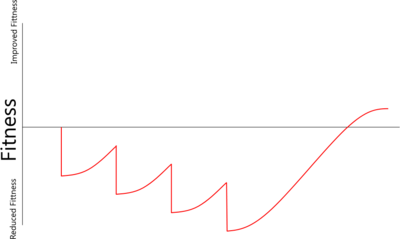Overload

Overload training involves repeated training bouts without sufficient time for recovery (Overtraining), which builds up fatigue. This overload period is then followed by a period of rest to allow for full recovery and Supercompensation to increase fitness. Care must be taken with Overload training to prevent Overtraining Syndrome. Overload training is a normal part of healthy, effective training. Overload (AKA 'functional overreaching') has a short term performance decrement, but without the severe psychological and long lasting negative symptoms of Overtraining Syndrome[1]. The key differentiation between Overload and Overtraining Syndrome is that Overload results in an overall performance improvement after recovery. Overload can be recovered from in a few days[2] and the Overload period is normally between a couple of days and 3 weeks[3]. Overload is part of a Three Phase Taper.
References
- ↑ Prevention, diagnosis and treatment of the Overtraining Syndrome http://www.ingentaconnect.com/content/tandf/tejs/2006/00000006/00000001/art00001
- ↑ Physiological Perspective of Endurance Overtraining – A Comprehensive Update http://ajms.alameenmedical.org/article_vol05-1-jan-mar-2012/AJMS.5.1.2012%20P%207-20.pdf
- ↑ Overtraining In Sport, Kreider, Fry, O'Toole, Human Kinetics